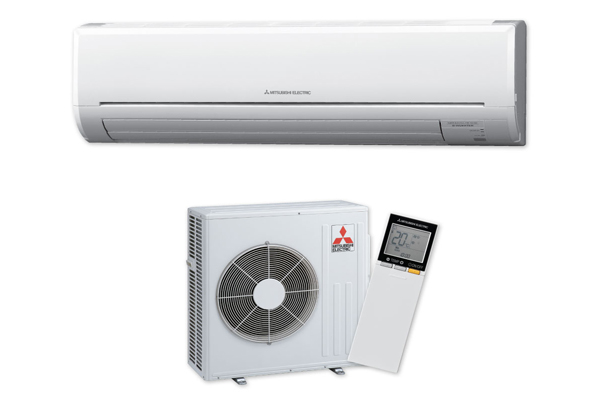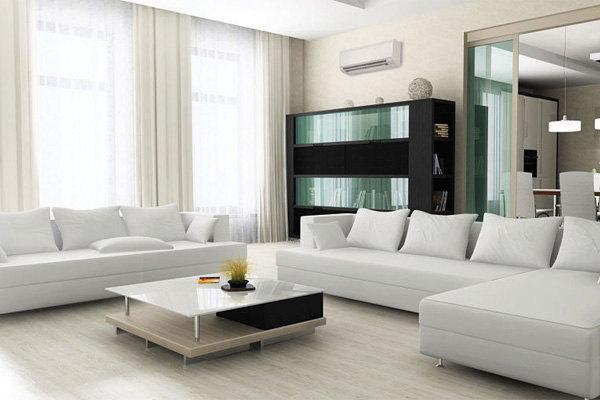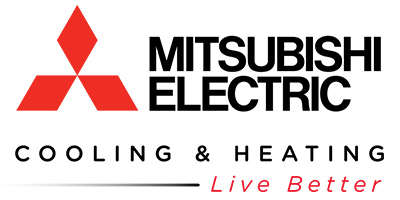
There are many types of mini-splits available in the market, including ceiling cassette, floor-mounted, floor-standing, and ceiling suspended. However, the most commonly used ductless mini-split is a wall-mounted ductless system. This is because installing it is a relatively easy task. It is also the most budget-friendly. This type of mini-split is also suitable for most types of rooms, such as bedrooms, living rooms, and dining rooms. These reasons make it the ideal heating and cooling choice for a lot of homeowners.
Wall-Mounted Ductless Unit Definition
A wall-mounted mini-split works like a traditional heating and cooling system does. The difference is that it is composed of an outdoor unit and an indoor air handler. The indoor unit houses the evaporator coils and the blower. Whereas, the outdoor unit is equipped with the vent fan, condenser coils, and compressor. They are connected via a conduit that passes via a three-inch hole in an exterior wall.
As its name suggests, this type of mini-split unit is mounted upon a wall in the room you want to heat or cool. A single unit can heat or cool a single room as it directly pumps the conditioned air in the area it is installed in. A wall-mounted unit has a sophisticated and compact design that matches most home interiors.
Wall-Mounted System Features
Wall-mounted systems offer many features to ensure that you receive optimal thermal comfort, efficiency, control, and performance. Listed below are a few of the essential features wall-mounted ducted units have:
Multi-Stage Air Filtration
Wall-mounted systems have advanced air filtration technology. This means that it can trap dust, allergens, and other types of contaminants. This ensures high indoor air quality, so you breathe clean and fresh air inside your home.
Modern Design
Most wall-mounted systems come in a modern and slim design. It also has a front panel that you can customize to fit your home’s interior design by getting it professionally painted or wrapped. Wall-mounted units are also built to last. They undergo durability tests, ensuring they are both aesthetically pleasing and can last for a long time.

Comfort Control
Every unit has return air sensors so wall-mounted systems can monitor zone conditions in real-time. The sensors are responsible for adjusting the unit’s settings so that thermal comfort is maintained. Some make and models are also equipped with infrared technology that can pick up human heat signatures in the room. This way, it can adjust the unit’s settings depending on the room’s occupancy.
Remote Control
There are many control options for wall-mounted units, depending on the make and model. It can be a handheld wireless remote. Others you can connect it to the Wi-Fi and control it through an app on your smart device. Select one which best fits your specifications and needs so you can maximize your ductless system’s capabilities.
The Pros & Cons Of A Wall-Mounted System
Before you go and buy a wall-mounted ductless system, it is best that you first look into the pros and cons of having one in your home. This way, you can make sure whether or not it is the right mini-split for you.
Benefits
A few of the advantages that a wall-mounted HVAC system has are:
- Wall-mounted A/Cs have advanced technology, making them highly energy-efficient. This way, you receive optimum comfort without an increase in your monthly electricity bills. Not only that, but this technology ensures that your system is environmentally-friendly as well.
- Unlike traditional HVAC systems, wall-mounted units do not need ducts to operate. This versatile application makes them the ideal choice for many types of buildings. Whether it’s a single-family home, condominium, or an apartment, a wall-mounted unit is an excellent choice.
- Wall-mounted units do not need ducts. This means that this type is easier to install compared to its traditional counterpart. The process usually lasts for a couple of hours, depending on how many units are to be installed. Installation is also less invasive. This is because there is no need to tear down walls or ceilings to install the ductwork.
- Wall-mounted systems provide high indoor air quality. Aside from the multi-stage air filters, it does not need ductwork. Ducts are known to be a place where dust, dirt, and other debris tend to accumulate. They are then circulated throughout your home. As the need for them is eliminated with a wall-mounted ductless system, you receive cleaner and fresher air.
Drawbacks
A wall-mounted system also has some cons, including:
- Mini-splits tend to have a higher initial cost than window ACs. If you have a larger house, you will need more indoor units to ensure thermal comfort, and this will undoubtedly cost more. However, although it may be pricier upfront, a wall-mounted mini-split can save you more money in the long run.
- It can be challenging to find the right placement for your wall-mounted unit. If you put it on the wrong spot, the unit might not operate as it should. Seek the help of a professional HVAC installer to assist you in finding the best place to install your wall-mounted unit.
- If you are a homeowner that highly values aesthetic appeal, then this system might not be for you. The system is visible in the zone it is installed in, and some homeowners dislike how obtrusive it looks.
Choosing A Wall-Mounted Ductless System
A wall-mounted mini-split offers conditioned air to an average-sized room that is at least seven to eight feet high. Wall-mounted units are typically used for areas such as living rooms, bedrooms, and small commercial spaces. If you are searching for a mini-split to cool or heat areas that have low or slanted ceilings, then a floor-mounted one is a better choice. It is highly recommended that the unit is installed at least six feet high on the wall so that the conditioned air circulates properly.
If you have a larger area and you want a wall-mounted unit, then a single unit may not be enough. You would need several indoor air handlers that are spread evenly across the room to achieve the desired thermal comfort. You can also opt to install another type of mini-split, such as a ceiling cassette or a ceiling suspended. These types of mini-split have more coverage and can ensure that larger rooms are cooled or heated adequately.
Wall-Mounted Mini-Split Installation

There are a few things to keep in mind during the wall-mounted unit installation. These include:
- Wall Depth Specifications: Check the wall depth specifications because various makes and models require various wall depth sizes. You might end up purchasing a system that doesn’t fit on your wall if you don’t.
- Bracket Installation: A lightweight wall bracket is included in every wall-mounted unit purchase. It needs to be secured to the wall properly before you mount the unit. Make sure that it is attached horizontally, or the system won’t be able to heat or cool the room properly.
- Vertical Surface: Make sure that the wall unit is installed on a vertical wall. Keep in mind that it won’t operate correctly when installed on a sloped wall.
- Ceiling Height: It is recommended that the wall-mounted unit is installed on a room that is at least seven to eight feet tall. This is because wall units are usually placed six feet high on the wall. Check the manufacturer’s specifications on the required space needed between the unit and ceiling so air is distributed properly.
- Exterior Wall Installation: It is recommended that the wall-mounted unit be placed against an outer wall. Installation is easier this way. It also makes drainage easier as you would not need to install a condensate pump to get rid of the accumulated water. Gravity will help drain the water through the drain tube instead.
- Install Away From Electromagnetic Interference: Make sure that the wall-mounted mini-split isn’t installed next to a television, microwave, or other devices that give off electromagnetic waves. Otherwise, the communication between the remote and the unit can be interrupted.
Check Out One Of Our Ductless Installation Projects
Mitsubishi Ductless Installation Project In Rocky Hill, New Jersey
Conclusion
Wall-mounted comes in many makes, brands, and models. To find the best one that will suit your lifestyle and other specifications, call a professional HVAC technician. Your trusted local mini-split installer can help you from start to finish, from choosing the right wall-mounted unit to installing it in your home. They can ensure that the wall-mounted you will purchase will fit your budget, aesthetic, and performance expectations.
Call PFO Heating & Air Conditioning To Learn More About Ductless HVAC Systems

For all your HVAC system needs, call PFO Heating & Air Conditioning today. Our technicians are all NATE-certified, and they have a great deal of experience. They’ll also determine what your home comfort needs are and find the best and most affordable solutions to meet them.
As a full-service HVAC company, PFO Heating & Air Conditioning offers an array of HVAC services. This includes heating and cooling installations, tuneups, repairs, and much more. We offer free, in-home consultations. Call now to schedule an appointment.
Click here to contact us now or call us at (800) 253-9001 to find out more!
The post Exploring The Wall-Mounted Ductless System appeared first on PFO Heating & Air Conditioning.
from PFO Heating & Air Conditioning https://www.princetonfuel.com/blog/wall-mounted-ductless-system/?utm_source=rss&utm_medium=rss&utm_campaign=wall-mounted-ductless-system
via IFTTT
No comments:
Post a Comment